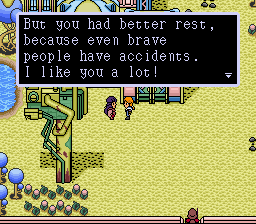Paladin’s Quest Review
In the vein of games like Arcana and 7th Saga, I picked up a copy of Paladin’s Quest. Unlike the former two, I find Paladin’s Quest to be quite tolerable in difficulty, if unintuitive. All three have their strong points, but PQ is by far the most playable.
The first thing you will notice about Paladin’s Quest (titled Lennus in Japan) is that the design is pretty wild. You’ll find 7 or 8 distinct races throughout Paladin’s Quest, and while every one is humanoid, not a single one is human. Many have twirly eyebrows, fins for ears, etc, etc. The most wild example is a late-game mercenary, who is clearly a hybrid of a few races – he has cat whiskers, a beard, some stubble *and* twirly eyebrows. He was, of course, my MVP in the final battle. It’s not just the characters who have interesting designs, either. The trees have circular tops, bringing to mind stories of The Lorax and Sneetches. You’ll find towns surrounded by magma, suspended by giant kites, and even – in one area – consisting of giant eggs with doorways.
Where the game unfortunately falls short is its music. After 7th Saga – with its several distinct and memorable town themes, on top of multiple battle and overworld themes, the soundtrack for Paladin’s Quest sounds alternately relaxed and grating. It didn’t quite reach the point where I wanted to turn off the sound entirely, but it came fairly close.
The core of the game, though, is good. In a break from traditional RPG mechanics, Paladin’s Quest has no MP – only HP, which is consumed for spells. It follows, then, that there are no healing spells whatsoever. One might justifiably ask if this can possibly be balanced – and the answer is that it can and is. Paladin’s Quest has surprisingly good balance from start to finish, with the only hiccup occurring right at the end of the game. PQ uses a mechanic which limits the number of healing items you can receive and use at a time – you fill bottles with medicine in towns. This goes well with a companion mechanic – no “item” menu in battle. You can only use what’s on your character, which might include one such bottle.
One mechanic I found interesting enough to place in a separate paragraph (!) was the magic system. As you progress, the primary characters (Chezni and Midia) gain access to new elements. Elements combine to make spells (e.g. Fire + Air makes “Fire All”). When you use elements in battle, the caster will gradually become more proficient. Most important of all, though, increased proficiency makes a character more resistant to that element when attacked. This means that unlike many RPGs with complex growth mechanics – Shin Megami Tensei, Suikoden 3, etc – one cannot ignore classes of spells entirely if one wants to make a character powerful.
Another system that I found interesting, especially just having played 7th Saga, was the mercenary system. You have four character slots, but only two are filled by permanent characters. The other two are filled with mercenaries – characters you recruit, usually for money, and dump when they’re no longer useful. Sometimes they’re plot related, but for much of the game they’re just side characters that add some flavor.
“Chezni” is an even better main character name than “Rooks”.
At this point, it’s hard to tell whether you will actually enjoy this game. It depends on your taste in RPGs – while Paladin’s Quest is certainly interesting and different, it is extremely light on story up until the end, and much of that story is optional “world” story level stuff. The premise will be familiar to many: your character does something very bad, and spends the rest of the game trying to make up for it.
Ultimately, of course, Paladin’s Quest is a product of its time. It is unpolished, a little clunky, has a few mistranslated bits (hell, the word “Paladin” never even comes up, to say nothing of the concept)… but it will give you a warm gooey sense of nostalgia – even if, like me, you never made it past the first couple sections when it came out.

